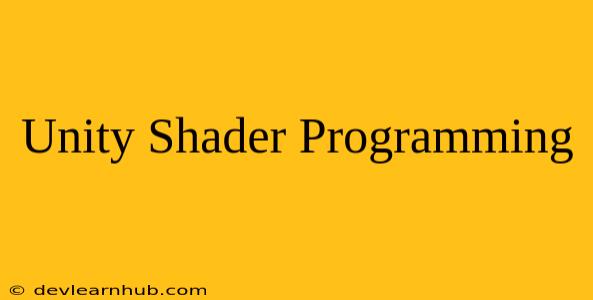Introduction
Shader programming is an essential aspect of game development in Unity, allowing you to create visually stunning and unique effects for your games. By understanding and utilizing shaders, you can control the appearance of materials, lighting, and other visual elements, pushing the boundaries of what's possible in your game world.
Understanding Shaders
At their core, shaders are small programs that run on your GPU (Graphics Processing Unit). They take input data, like the position of a vertex or the color of a texture, and process it to determine how the final pixel should look on your screen.
Types of Shaders in Unity
Unity supports two main types of shaders:
1. Surface Shaders
- Surface Shaders are a higher-level abstraction, making them easier to write and understand.
- They use a simplified syntax and provide built-in functions for common shader tasks.
- They are ideal for beginners and creating basic visual effects.
2. Vertex and Fragment Shaders (HLSL)
- Vertex and Fragment shaders (using HLSL – High-Level Shading Language) offer more granular control over the rendering process.
- You have complete control over the vertex positions, colors, and other attributes, and you can write custom code for both vertex and fragment processing.
- This gives you more flexibility for advanced effects and optimizations.
The Shader Graph
Unity's Shader Graph is a powerful visual scripting tool that allows you to create shaders without writing code. It provides a node-based interface where you connect nodes representing different shader functions to create complex effects.
Getting Started with Shader Programming
1. Creating a New Shader
- Navigate to Assets > Create > Shader.
- Choose the type of shader you want to create (e.g., Unlit, Standard, or a custom shader).
2. Writing Shader Code
- In the shader file, you'll write code using either the Surface Shader syntax or HLSL.
- The code typically defines the shader's properties (like color, texture, or other parameters), and then implements the logic for processing the input data.
3. Applying the Shader to a Material
- Create a new material (Assets > Create > Material).
- Assign your newly created shader to the material.
- Adjust the material properties to customize the shader's appearance.
Key Concepts in Shader Programming
- Vertex Shader: This stage determines the position and attributes of each vertex in your mesh.
- Fragment Shader: This stage determines the color of each pixel on your screen.
- Textures: Images used to provide visual detail, patterns, or information to your shaders.
- Lighting: Calculating how light interacts with surfaces.
- Shader Properties: Variables defined in your shader that can be adjusted in the material inspector.
Resources for Learning
- Unity Manual: https://docs.unity3d.com/Manual/Shaders.html
- Unity Learn: https://learn.unity.com/
- Shadertoy: https://www.shadertoy.com/ (Explore and learn from other shaders)
Conclusion
Shader programming in Unity opens up a world of possibilities for creating stunning visuals and unique game experiences. By mastering the fundamental concepts, you can add a new level of depth and complexity to your game projects. Start experimenting with shaders today, and see the creative potential they unlock!
